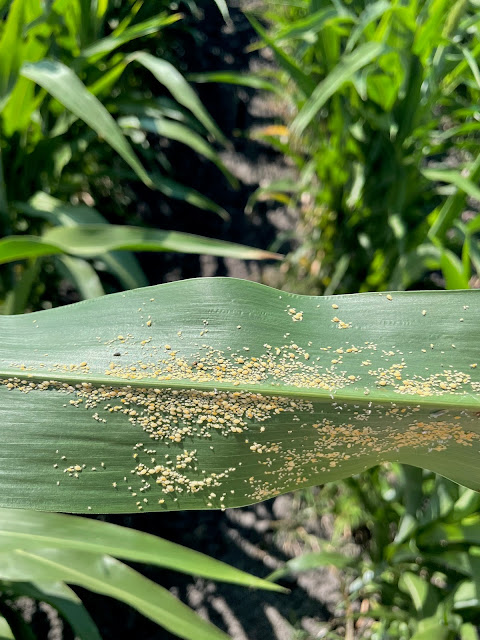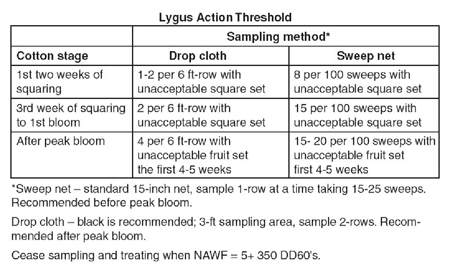Howdy,
We have both the Wharton County Turn Row Meeting and the Matagorda County Crop Tour going on this Thursday. Wharton county's meeting starts at 9:00 at the soybean variety trial, and the Matagorda county meeting will be at 2:30 at the El Maton National Hall. We look forward to seeing you there!
This week has been hot and dry. Most of our cotton is between 5-8 nodes above white flower (NAWF). I have a couple fields at cutout, and others that will be in the next two weeks. Cutout occurs when carbohydrate supply equals demand, and vegetative growth ceases. When the plant reaches cutout, no more harvestable fruit is set. This is normally at 4 to 5 NAWF. I've included heat unit charts below to help with spray decisions for our insect pests as our fields reach cutout. Temperature data for each county location is based on a field close to the center of each county. Cotton is no longer susceptible to economic damage by plant bugs and bollworms at 350 degree days (DD60), or heat units, past cutout, and is no longer susceptible to economic damage from stink bugs at 450 DD60 past cutout. Bolls that will reach maturity by harvest will be too hard for the respective pests to feed on at this stage.
Our bollworm egg lay has picked up a bit, and we are seeing very light damage on some of our smaller fruit, and a few neonate worms. There are also scattered lygus bugs and verde plant bugs below threshold in a few places in all three counties. We are checking bolls for stink bug damage now as well. In the fields we've seen stink bugs we've only seen brown stink bugs so far. Below is my scouting information for the week of 6/17/2022.
 |
| Cotton Aphid Kate Crumley |
The threshold for cotton aphids is 50 aphids per leaf, and if you see aphid mummies in the field (tan or black dry and unmoving aphids), that's a good thing. Parasitoid wasps lay eggs in the aphids, and the aphid forms a mummy while the wasp larvae is pupating inside. These wasps, lady beetles, and lacewings can knock back aphid populations. Treatment for aphids is rarely justified, but I have seen some cotton at threshold this year. If you do decide to treat for aphids, do not use a pyrethroid. Pyrethroids and organophosphates are broad spectrum, and kill beneficial insects as well as your target insect, but pests like aphids bounce back much quicker than their predators do. Their high reproductive rate will allow their numbers to soar after a broad spectrum insecticide application kills all their predators.
 | ||
Aphid Mummies on Cotton
Kate Crumley |
 |
| H. zea Larvae Kate Crumley |
Our Bt traits overlap across corn and cotton. If the caterpillars survive the traits on corn then as adults fly to cotton to lay eggs, it's likely their offspring will survive the same traits on cotton. Below is a chart showing the overlap of Bt traits between crops and technologies.
 |
| H. zea Eggs on Cotton Kate Crumley |
 |
| Evidence of Sucking Insect Damage on Cotton Boll Kate Crumley |


 |
| Sugarcane Aphids in Sorghum Photo: Kate Crumley |
In sorghum we need to be scouting for sugarcane aphid, those are building with the drier weather. I've picked it up in sorghum in all three counties, and there are fields that reached threshold for it already. If it's blooming, we need to look for sorghum midge. Here are some links for just sugarcane aphid, and a more recently updated guide for sorghum insect management. Here are links to the threshold calculators for sorghum midge, rice stink bug, and sorghum headworm. I am picking up low numbers of headworms and rice stink bug right now.
I'd also like to let everyone know that there is an Agricultural Pesticide Waste Collection event happening on Wednesday, June 29th from 8:00 am to 12:00 pm at the Victoria County Pct #4 Yard at 226 Beck Road East, Inez, TX 77968. The flyer for that event is below. For any additional questions on this event, please contact the Victoria County Extension Office at (361)-575-4581.
Please check out our weekly IPM Audio Updates, the website to sign up to receive those is listed below. If you have any questions feel free to contact me either by email or calling the office. Have a good weekend, everyone!
Sincerely,
Kate Crumley
Check out our weekly IPM Audio Updates
Cotton Insect Management Guide
Development and Growth Monitoring of the Cotton Plant



















No comments:
Post a Comment